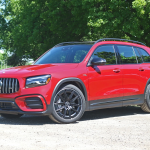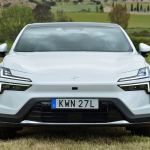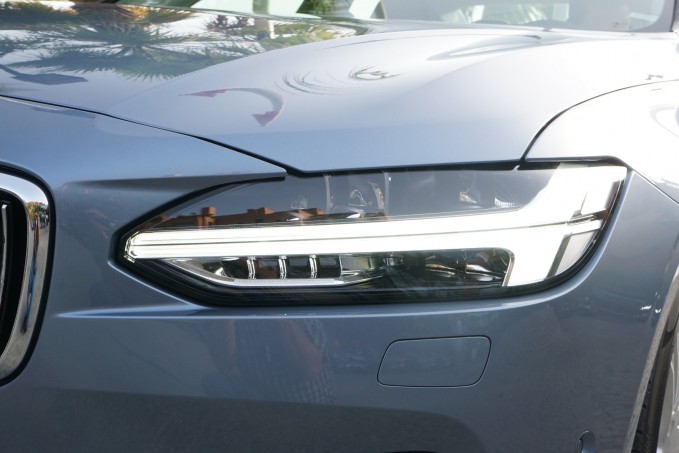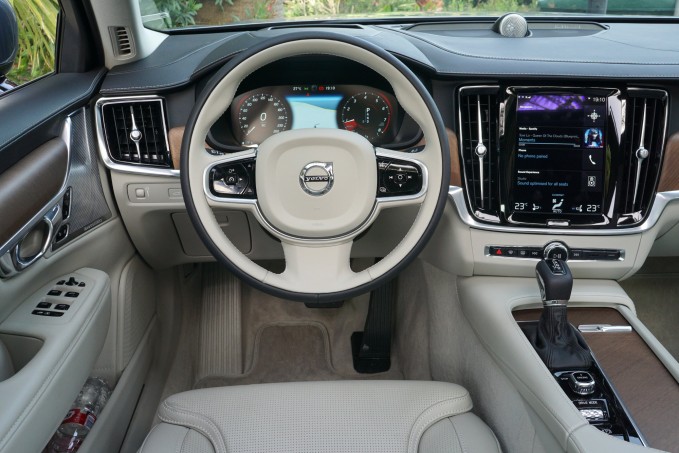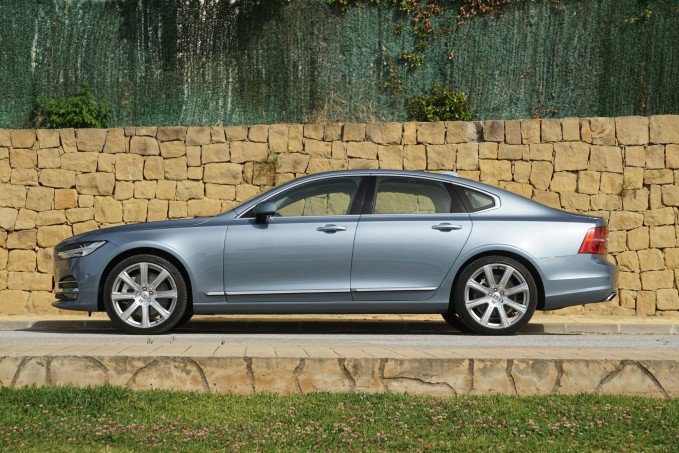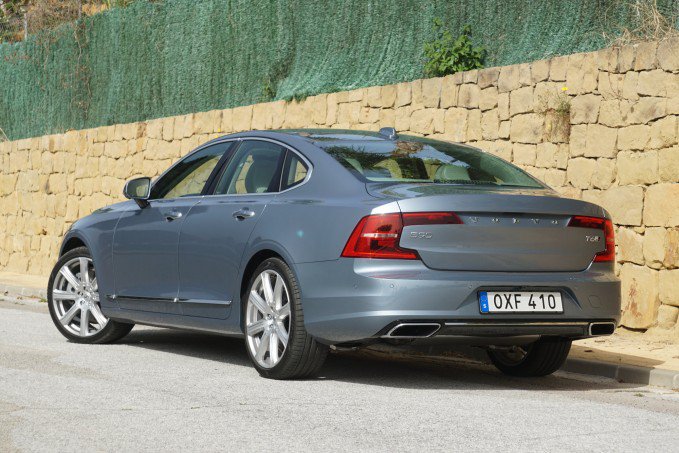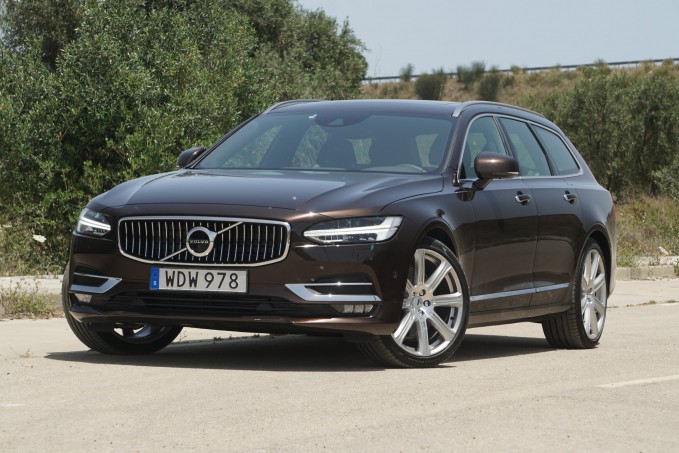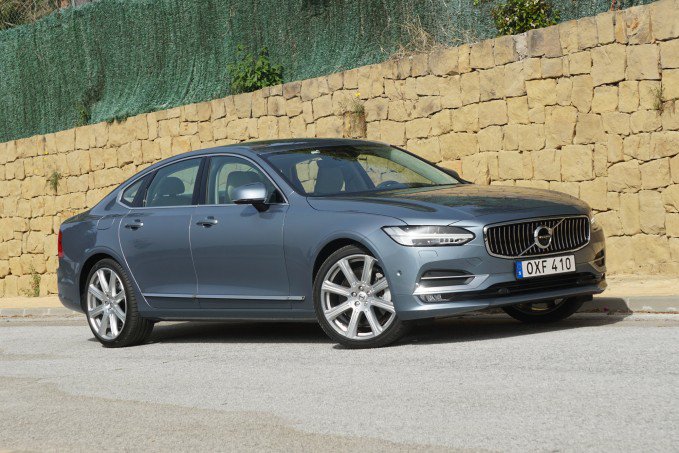Volvo’s goal for the all-new S90 sedan (and its soon-to-follow wagon variant, the V90) is a lofty one: March into battle against cars like the BMW 5 Series, Mercedes E-Class, Audi A6, Lexus GS, and Cadillac CTS and walk away with five percent of sales in the segment.
Carving Out a Niche
That last part is the important one, because while we can’t see die-hard BMW and Mercedes fans jumping ship en masse to the Swedish automaker, we can envision a narrow yet steady stream of buyers who like the luxury and solitude provided by German cars but don’t care for certain aspects of ownership, such as the complex controls or the less-than-flattering perceptions of their owners. Volvo has done what any smart niche player would do: They’ve created something truly different.
The focus of the S90 is design. The exterior, with its long hood and coupe-like profile, is meant to recall Volvo’s classic P1800 coupe, but we like it mostly because it looks strikingly different from its competitors.
The T-shaped daytime running lights (“Thor’s hammer,” says Volvo) are cool, as is the grille with its concave ribs and redesigned Volvo logo. Only the massive C-shaped taillights—which appear to be spreading across the expanse of the trunk lid like a fungal experiment gone mad—detract from the design.
Inside, Volvo has followed the theme they introduced in the XC90. Like many luxury automakers nowadays, Volvo is embracing the “genuine materials” movement with religious fervor: Leather, open-pore wood, and real metal dominate the S90’s dash, with squared-off vents that remind us vaguely of Lincoln’s design motif from the 1960s (and believe it or not, we mean that as a compliment). We sampled both dark and light interiors, and while the former will no doubt please German-car purists, it was the latter that really conveyed the oasis-like feel that Volvo is looking to deliver.
Simplify your Interior
Volvo’s answer to the complicated multimedia and infotainment controls inflicting so many of today’s luxury cars is a vertically-oriented central screen that mimics the functionality of tablets and smartphones, complete with pinching and swiping motions. There’s even a big “home” button at the center just below the screen, just like an iPad. Though the interface takes some getting used to, we like the way it compartmentalizes information and makes it easy to find what you want. Volvo has pared actual physical buttons down to the bare minimum: A few that are legally mandated (hazard lights, front and rear defroster) along with a big play/pause button for the stereo surrounded by a proper volume knob.
The front seats are supportive and comfortable—we’d expect no less from Volvo—and the back seats offer plenty of legroom, while the trunk will happily accommodate enough luggage for a long vacation—which is appropriate, as the S90 impressed us a great road-tripper.
A Change in Power
In terms of raw driving excitement, the S90 doesn’t quite deliver like the big-engine versions of its competitors, though it’s certainly no slouch. Volvo is in the process of altering nearly everything about their cars, and one of the biggest changes is that all Volvos sold in the US will have a two-liter four-cylinder engine, available in various power levels. We drove the (current) top-end version, the T6, which uses a combination of turbocharging and supercharging to boost its power output to a V6-like 316 hp and 295 lb-ft.
We were impressed by the way the T6 hand
led highway on-ramps and quick passing on two-lane roads, and amazed that such a small engine can do such a good job hustling such a big car. The T6 can certainly hold its own against the turbocharged fours and non-turbo sixes found in the competition. The supercharger/turbocharger combination eliminates most of the low-RPM lag typical of turbo cars, which is nice, but it doesn’t have the raw muscle to match the turbo sixes and V8s offered as options in the S90’s competitors.
While we only got to sample T6-powered S90s, Volvo will offer a less-powerful version of the engine called the T5, which does without the supercharger and provides 250 hp and 258 lb-ft of torque. The big difference—besides power—is that the T5 will come exclusively with front-wheel drive while the T6 will offer all-wheel drive. EPA fuel economy estimates had not been announced at the time of our test drive, but we imagine the fuel economy penalty for the T6 engine and all-wheel drive will not be too severe compared to the front-drive T5.
Farther down the road is the T8 plug-in hybrid drivetrain, just now being introduced in Volvo’s XC90 SUV. This setup adds an electric motor/generator to the T6 engine, which drives the front wheels; an electric motor powers the rear wheels. While Volvo is (obviously) pushing the fuel economy benefits of this setup—plus the electric-only driving ability and ability to charge the battery from an external source—it’s the power we’re interested in. With an expected 407 total system horsepower, this could be the performance variant that gives the Audi A6 3.0T, BMW 535i and Cadillac CTS V-Sport a run for their money. Unfortunately, we expect the plug-in hybrid system to make this a much more expensive option for the Volvo than the big engines in competing cars.
Long Live the Wagon
While we didn’t get a chance to try the T8, we did get the opportunity for a quick drive in the V90 wagon. Bear in mind that as automotive writers, we are genetically predisposed to like wagons, though most of our fellow citizens prefer SUVs. The V90 does help make our case: It’s arguably more attractive than the sedan, with taillights that climb the pillars to recall big Volvo wagons of yore. It has the same lovely backseat accommodations as the S90 sedan, and while some recent wagons have skimped on cargo space (we’re looking at you, Audi Allroad Quattro), the Volvo looks to be a decent load carrier, though we don’t have precise EPA volume numbers just yet. The V90 will go on sale next year as a 2018 model.
Pricing
Volvo has announced US pricing for the S90 T5 Momentum at $47,945 (including destination charge), a price that includes leather interior and the full suite of safety packages for which Volvo has become so well known (all except blind spot warning, which Volvo has come to realize can be more of an annoyance than an aid). A top-of-the-line T6 Inscription model with all of the options will list for $67,505. That puts the S90 squarely in BMW 5 Series territory, though the Volvo does offer more standard equipment and a shorter (but no less thorough) list of options. In terms of value for money, it’ll have a tough time against the Audi A6, which remains the bargain buy in the mid-size luxury set.
The Verdict: 2017 Volvo S90
Still, we don’t expect the S90 to sell on price, but rather on pure appeal. The S90 is a good alternative for those who want a European luxury car that isn’t tied to the German way of doing things. Here’s a car that looks different inside and out—and let’s not downplay Volvo’s decades-old obsession with safety, a selling point that, if not emphasized, is inherently understood. This is a luxury sedan that delive
rs on its promises, and we like it. Five percent? Should be no problem.



